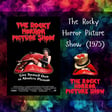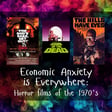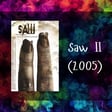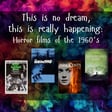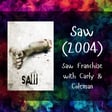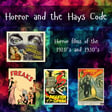Introduction to 'What Haunts You'
00:00:27
Speaker
Welcome to What Haunts You, a podcast about the stories that haunt our dreams. I'm your host, Carly. You can find episodes of What Haunts You now on both YouTube and Spotify.
00:00:39
Speaker
Feel free to subscribe or follow and turn on notifications for new episodes. You can also find us on Instagram at whathauntsyoupod, where you can stay up to date on what we're talking about on the podcast.
00:00:52
Speaker
Let's get into it.
Post-WWII Fears and Media's Role
00:00:54
Speaker
In the 1940s and 1950s, the world was reeling from World War II and its aftermath and the start of the Cold War.
00:01:03
Speaker
There were new fears unlocked in the hearts and minds of average people across the globe. There was a new level of destruction that was not only imaginable, but that people actually witnessed for the first time through photos and videos.
00:01:17
Speaker
Alfred Hitchcock himself was one of the directors responsible for filming footage of concentration camps, not just to prove what happened, but to ensure that we really remembered what happened.
00:01:30
Speaker
Unfortunately, our memory of what happened in the Holocaust and how it happened has still managed to get pretty foggy since then. which we can see in a lot of different ways today.
00:01:42
Speaker
But at the time, it felt really important to people that this was etched in the memory of humanity for years to come to avoid another catastrophe like this one because this war saw destruction on such a new scale.
Impact of 1940s Production Code on Horror Films
00:01:56
Speaker
In the movie world in the 1940s, the production code was alive and well, affecting how far horror movies could go, what issues they could address, and what topics they could explore.
00:02:08
Speaker
We discussed the production code in some depth in our previous episode, Horror and the Hays Code. The production code was made partially in response to the success Jewish creatives had found in Hollywood,
00:02:21
Speaker
and the anti-Semitic belief that Jewish people were sexually perverted, like lacked morality and decency, and were going to corrupt the American people through their films.
First Amendment and Film Art Status
00:02:32
Speaker
But in 1952, thanks to the trial of Joseph Burstyn, Inc. v. Wilson, the code was more or less killed by the ruling that film is an art form under the protection of the First Amendment, or the right to free speech.
00:02:47
Speaker
Now, this didn't eliminate all forms of censorship or regulation for movies, but it was the start of a new era, one where regulations around what could be shown in film started to shift away from the puritanical and moralistic regulations that had been there under the production code.
00:03:06
Speaker
The 40s were a fraught time. They were moving out of the Great Depression and into World War two And both of those events opened people's eyes to the way humanity can be so cruel and violent and suffer so, so much.
00:03:21
Speaker
People were seeing what humans were capable of, be it due to war or due to desperation.
Humanity's Violent Nature in 1940s Horror
00:03:29
Speaker
Some of the first horror movies of the 1940s explore the violence that some believe lay dormant in all humans, almost as an essential part of our nature.
00:03:40
Speaker
Our violent impulses that might never come out if not for extreme situations are brought out in horror movies through transformation, the transformation happening sometimes through science and sometimes through something closer to magic.
00:03:55
Speaker
people were starting to see what kind of depravity humans were really capable of, and these movies allow people to cope with knowing what humans are capable of at their worst when their better natures and impulse control are overridden by outside forces.
Metaphor of Duality in 'Dr. Jekyll and Mr. Hyde'
00:04:13
Speaker
We see this in the 1941 version of Dr. Jekyll and Mr. Hyde, where a scientist, upon drinking a concoction of his own making, transforms into a dark, aggressive version of himself.
00:04:25
Speaker
He is violent and wreaks havoc on the people around him, behaving in ways that he never would when he's his normal self. Dr. Jekyll is a mild-mannered, albeit potentially arrogant, scientist, and Mr. Hyde is the kind of human being that people would probably call a monster.
00:04:45
Speaker
In addition to the dichotomy of good and bad we see in this movie, we also see far more dramatic transformations where humans don't just unleash their animalistic aggression but actually become animals, which was a common motif among early nineteen forty s movies.
Male Violence in 'The Wolfman'
00:05:03
Speaker
Humans act at times in ways that can be hard to wrap our heads around. Couched in the behavior of a beast or a monster, it is easier to imagine the violence that humans are capable of.
00:05:16
Speaker
Violence and aggression are explored through these transformations into animals and the animalistic behavior that follows.
00:05:24
Speaker
1941's The Wolfman shows a man who, against his own will, turns into a violent monster. One who will attack his fellow humans, even the ones that he cares about.
00:05:35
Speaker
The movie explores the societal fear of violent impulses of humans, but perhaps more specifically, the violent impulses of men and what happens when men are unable to control those impulses.
00:05:49
Speaker
In The Wolfman, Lon Chaney Jr.'s character is attacked by a wolf. He's bitten, but then proceeds to beat the wolf to death with a cane that coincidentally has a wolf for a handle.
00:06:02
Speaker
The next day, a human body is found dead in its place, and the idea of a werewolf starts to enter the frame. This is all happening as he is connecting with this woman who is already engaged to be married to someone else.
00:06:16
Speaker
So there is this forbidden love element that becomes even more forbidden as his violent impulses reign and the damage becomes unavoidable.
00:06:26
Speaker
The transformation scene in this movie is really well done. The effects are great and hold up surprisingly well, but what really delivers the scene is Chaney's performance.
00:06:38
Speaker
The distress is plain on his face as he watches his feet become more and more like paws and the rest of his body follows. He knows that this is the end of his self-control, the end of his ability to think before acting.
00:06:54
Speaker
After the transformation is complete, he's violent, but he also seems scared. Scared of being found or found out, but I think also scared of himself and what he is now capable of.
00:07:07
Speaker
And I think it is crucial that the Wolfman is not just a man who turns into a normal wolf. He's truly a wolfman. He's sort of bipedal and distinctly humanoid as a wolfman.
00:07:20
Speaker
He doesn't just look like a wolf. This movie seeks to exorcise some demons about the violence that humans, and especially men, are capable of, and the violent impulses that some humans have.
Monsters Reflecting Human Fears
00:07:34
Speaker
It's exploring what happens when the humanity can't win out over the violent impulses. So he can't just be a man who turns into a normal wolf. He needs to maintain some elements of his humanity on a visual level that the audience can see.
00:07:51
Speaker
Because while him being a wolfman gives the audience some distance from the violent impulses being explored, the audience doesn't really get to forget that this is actually a man underneath it all.
00:08:05
Speaker
There is something interesting about the werewolves reverting to their human form when killed. It's like a direct reminder that despite all this uncontrolled and violent behavior, this is still fundamentally a human.
00:08:20
Speaker
And this is true of the people exhibiting the most violent behaviors in real life too. We like to call people who do things we consider unimaginable monsters.
00:08:30
Speaker
And in more modern times, we also like to use words like sociopath and psychopath. But ultimately, even the people who are committing the most violent acts imaginable are still just people.
00:08:44
Speaker
And it would serve us as a society to remember that. Adolf Hitler himself, arguably one of the most violent men in history, had a fascination with wolves and werewolves.
00:08:56
Speaker
He associated them with aggression in a way that was aspirational rather than fearful. American horror movies associated wolves with aggression in a way that was not only fearful, but seemingly confused about how human that kind of aggression could really be.
Female Sexuality in 'Cat People'
00:09:14
Speaker
The 1942 movie Cat People differs from Wolfman and other similar movies in one crucial way, and the fact that it centers around women.
00:09:25
Speaker
And because of this, it demonstrates some of the differences in what scares society about men and what scares society about women. Men and women both are seen as needing to repress their baser impulses, but they aren't repressing the same impulses.
00:09:42
Speaker
While Wolfman focuses on the repressed violent impulses of men, Cat People focuses on the repressed sexuality of women. Women today are still barely allowed to be openly sexual beings.
00:09:56
Speaker
It was even more important back then for women to keep their sexual urges and impulses under wraps. So much so that the main character, Irina, is concerned about becoming a violent panther upon consummating her marriage.
00:10:11
Speaker
It is her own developing sexuality that threatens not just her, but her potential husband and the other people around her. She is afraid of her own sexuality, but we can only imagine that this fear is something that has been instilled in her by a patriarchal society that is terrified of the idea of a sexually empowered woman or even a woman who enjoys sex.
00:10:36
Speaker
While for men it is outright violence that gets rightfully labeled as dangerous, for women it is passion and sexuality that get labeled as dangerous. And this movie puts a fear of female sexuality on display.
00:10:53
Speaker
many people also take a queer read on the movie, largely influenced by a scene of Irina celebrating her wedding at a local restaurant where she is watched and eventually approached by another woman who refers to Irina as, quote, my sister.
00:11:10
Speaker
The fear on Irina's face in response speaks to her concern that she will be seen for being the same kind of woman as this woman, who is also referred to as looking like a cat.
WWII Influence on Horror Themes
00:11:23
Speaker
It's a moment that mainstream audiences could view as this woman also having the potential to turn into a panther in a state of arousal, but to queer audiences of the time and queer audiences since, the juxtaposition of Irina being labeled as odd in the same scene with this woman addressing her as sister have queer undertones that are there for anyone open to noticing them.
00:11:51
Speaker
After World War II ended, people were exposed to images and footage of concentration camps, as well as the results of the bombings of Hiroshima and Nagasaki. The fears caused by these large-scale incidents of violence are demonstrated in two of the prominent types of horror films of the 1950s, the alien invasion movies and the giant radioactive animal or monster movies.
00:12:17
Speaker
Crucially, it was also in 1947 that the Roswell UFO incident happened and aliens were thrown deeper into the public consciousness.
00:12:28
Speaker
Americans, particularly white Gentile Americans, have a tendency to feel kind of invincible. There isn't a thought that something like the Holocaust could really happen to them at the hands of other humans because there is a kind of sense of inherent superiority of sitting on top of the ladder.
00:12:47
Speaker
White Gentile Americans are the conquerors and never the conquered, despite what white nationalists will try to claim today. Despite the sense of heroism that many Americans had after winning World War II, white Gentile Americans had a lot more in common with the average German citizen than they did with the Jews, the Romani people, and the other marginalized people in concentration camps.
00:13:12
Speaker
But the fear was still there. What would it be like to be the conquered? To be targeted by quote-unquote superior group? To be overpowered, whether it was by numbers or by technology?
00:13:25
Speaker
This question fuels the proliferation of alien invasion movies, where Americans got to wonder what it would be like to be the target. The target for dehumanization, for enslavement, for extermination.
00:13:40
Speaker
While Gentiles were exploring this fear in more of a hypothetical way, American Jews working in Hollywood were likely working out their own trauma of knowing what happened to their family members overseas.
00:13:53
Speaker
They were trying to make sense of the losses they had experienced directly and to the devastation that their people were experiencing as a whole. So there are two groups of people working side by side on these movies.
00:14:06
Speaker
For one group, it was
Sci-Fi Films and Holocaust Metaphors
00:14:08
Speaker
essentially a thought exercise, while for the other, it was an attempt to wrap their minds around something almost impossible to truly understand.
00:14:18
Speaker
In the introduction of Planet Auschwitz, Holocaust Representation in Science Fiction and Horror Film and Television, Brian E. Krim writes, quote, "...I believe the supernatural and extraterrestrial are rich and wonderfully complex spaces in which to examine important Holocaust themes." Trauma, guilt, grief, ideological fervor, industrialized killing, and the dangerous afterlife of Nazism after World War II.
00:14:49
Speaker
He goes on to quote scholar Gavriel Rosenfeld, saying, quote, tales of what never happened can help us understand the memory of what did. It's questionable whether real footage or real photographs of the concentration camps can adequately express the horror of those places and what the people in them went through.
00:15:11
Speaker
It raises a question that I personally think about a lot for a lot of topics. Is it more important to express what is factual or what is honest? And are those two things always the same?
00:15:25
Speaker
Do fictional stories that evoke visual or thematic elements of real life atrocities, tragedies, and disasters provide us something that simple facts cannot?
00:15:36
Speaker
I personally think yes, they do. As it relates to alien invasion movies, Krim writes, quote, "...post-Holocaust science fiction tends to revolve around isolation, survival in extreme environments, and the destruction and rebirth of civilization after an apocalyptic event." Alien contact is a natural metaphor for dehumanizing racism and extermination fantasies.
00:16:06
Speaker
Science fiction constructs worlds and scenarios analogous to past genocides, subtly evoking historical memories and iconic imagery that encourage audiences to contemplate these signposts and perhaps perceive the world differently.
00:16:24
Speaker
Basically, science fiction asks the dominant group to wonder what it would be like to be viewed as less than, to be viewed as disposable, and to be threatened with extermination.
00:16:36
Speaker
these movies pushed audiences, predominantly white Americans, to put themselves in someone else's shoes by forcing the situation on people that they see themselves in.
'War of the Worlds' and WWII Parallels
00:16:48
Speaker
And it gave Jewish creatives in Hollywood an outlet to express what they or their families went through in a way that didn't just evoke sadness, but evoked existential fear, the way that a tragedy of that scale should.
00:17:03
Speaker
While realistic depictions of the Holocaust often evoke feelings of sadness, maybe of pity, hopefully of some empathy, horror and sci-fi metaphors for it can evoke a sense of something brewing beneath the surface, something on the horizon that will put everyone in imminent danger, and the fear and the dread that the worst can always happen.
00:17:28
Speaker
This all sounds a little bleak, I know, but one of the things about horror is that we get a chance to vent or process emotions like this and actually still get to have fun while we're doing it.
00:17:41
Speaker
One of the most challenging parts about being a human is holding two conflicting feelings at the same time. But these old sci-fi horror movies ask us to do just that.
00:17:52
Speaker
Because they ask us to contemplate the worst of the worst, but to have fun while we do it. And somehow it works. The original War of the Worlds movie opens with footage of World War II, immediately prefacing this story of invasion and attempted extermination with the version of it that we had already seen.
00:18:14
Speaker
The scene where they are waiting to see the aliens for the first time is amazing. The reporters are there, ah crowd is gathered, everyone is waiting to see who or what is coming out of that meteor.
00:18:28
Speaker
It's the moment of truth and it's an immediate attack, leaving the characters and the audience wondering just how far are they going to take this? Later, as they're discussing the locations that are being targeted by the invaders, a soldier reports, quote, they're working to some kind of plan.
00:18:47
Speaker
Now, what it may be isn't clear yet, simply because once they begin to move, no more news comes out of that area. It calls to mind what things may have been like for Jews in European ghettos, knowing that ghettos were being invaded and people were being taken.
00:19:06
Speaker
Massive communities of Jews were being emptied out with very little word going back, save for those who escaped the fates awaiting the rest of their people. People didn't know what to assume or what to believe about what was happening once the ghettos were really fully overtaken.
Jewish Historical Perspective in Alien Films
00:19:25
Speaker
Eventually, what little word there was stopped coming from different ghettos as they were emptied out. The mind races, imagining potential outcomes of the situation, the good, the bad, and the ugly.
00:19:39
Speaker
Similarly, alien invasion movies tend to have a period of suspense between invasion and whatever comes next, where people are left to wonder what fate they are in store for or what fate has befallen their fellow humans.
00:19:55
Speaker
It gives people time to imagine the worst possibilities and to wonder whether they need to be preparing for an attempt at extermination. The narrator in War of the Worlds clarifies what does come next.
00:20:09
Speaker
mass extermination and displacement of survivors. The violence is astronomical, no pun intended. The humans are losing, and naturally it is up to the United States to defeat these evil invaders.
00:20:24
Speaker
And the Americans do find a way, but similarly to in World War II, it was kind of too late for heroism. People were wiped out en masse, but that never stops Americans from viewing themselves as heroes.
00:20:39
Speaker
whether it's the hero of the Holocaust or basically the hero of anything that's happened since. The Americans in the movie approach the situation by deploying the largest bomb ever detonated, which obviously sounds familiar in the wake of World War two This fails, and eventually the Martians are taken down by viruses and bacteria on Earth that they have no immunity to, which, again, sounds familiar to American history.
00:21:07
Speaker
But before the aliens are defeated, we see the humans forced into buildings while everything around them is set on fire. They happen to be crowded inside a church, but the imagery still calls to mind pogroms. When Jews were rounded up, property and lives were destroyed, and many were killed or taken into camps.
00:21:28
Speaker
A crowd of people huddled together inside as their town is destroyed and vicious invaders roam the streets seeking out targets for violence is not an unfamiliar concept.
00:21:42
Speaker
In the wake of World War II, the United Nations was developed to promote cooperative relationships between nations and in the hopes of preventing another world war, with the knowledge that weapons would keep getting bigger and the potential scale of destruction of future world wars would also continue to grow.
Post-WWII Unity Themes in Film
00:22:01
Speaker
But alongside the development of the UN n to hopefully avoid another world war, a new kind of war emerges as the United States and the Soviet Union enter into the Cold War. fought through technological development and proxy wars like the Korean War and the further development of nuclear weapons.
00:22:20
Speaker
There was an awareness of a need for cooperation among nations, but there was also an increasing divide based on these two superpowers battling it out and getting so many other countries involved and causing huge amounts of destruction and in countries with less global power.
00:22:39
Speaker
This tension between a need for positive international relations and increased global fear and tension due to the Cold War comes up in the 1951 movie The Day the Earth Stood Still.
00:22:52
Speaker
In this classic film, the very human-looking alien nearly immediately demands to speak to all of the world leaders, together. He is demanding that humans join together, that different nations join together.
00:23:07
Speaker
there is an immediate theme of forced unity under dire situations outside of our current realm of understanding. This being made so shortly after World War II and so shortly after the development of the United Nations is telling, the alien even references the United Nations.
00:23:25
Speaker
The world was starting to see that it might be necessary to create a more united front. People were starting to imagine a world where many nations could work together, but this vision was tainted by the tension of the Cold War.
00:23:41
Speaker
It was a strange time where there was this template for cooperation found in the UN, n but... there was also a battle raging behind the scenes, superpower versus superpower.
00:23:52
Speaker
The division didn't erupt into outright violence for the Soviet Union or the United States, but the threat of violence and destruction loomed large as both countries worked on building bigger and stronger weapons, fought in proxy wars, and competed in the space race.
00:24:07
Speaker
And although there wasn't as much outright violence in either of these countries, they caused a lot of outright violence in other countries. But throughout the film, there is this consistent push from the aliens for nations and peoples to come together.
00:24:23
Speaker
This information is too important to entrust to one individual, the alien says. This movie values community and cooperation and recognizes that as the stakes get bigger...
00:24:37
Speaker
the more the need to work together and see each other's value and humanity increases too. And this message is timeless even today as we think about confronting issues like climate change and the level of cooperation it would require for us to really make a difference in the course of our natural world.
Cold War Anxieties in 'Godzilla'
00:24:57
Speaker
The fear we face today of climate change brings new context to another monster movie, The Blob, where the plan is to, quote, take this thing to the Arctic or somewhere where it will never thaw out, which is very ominous to hear in the era of melting ice caps.
00:25:15
Speaker
Even the character in the movie says that things will be fine, quote, as long as the Arctic stays cold. Now, the biggest threats to our natural world are large-scale pollution, and climate change.
00:25:29
Speaker
Back then, the biggest threat to the natural world seemed to be the development of nuclear power, a threat explored through another prominent sci-fi horror subgenre of this era, the giant radioactive monster movies.
00:25:44
Speaker
Sometimes they were actual monsters, sometimes they were normal animals made giant by exposure to radiation, but they are always giant harbingers of destruction on a scale only recently discovered through the discovery of nuclear weapons.
00:26:01
Speaker
I'm going to start us off with perhaps the most iconic nuclear movie monster of all, the original Godzilla from 1954. Godzilla was an ancient monster woken up by H-bomb testing in the sea.
00:26:14
Speaker
We live in a world where Godzilla is kind of a ubiquitous monster, so it's easy to forget what a symbolic story it really started out as. But it's plain as day that Godzilla is a stand-in for nuclear weapons, for the largest-scale destruction the world could imagine, that the world no longer had to imagine after the bombing of Hiroshima and Nagasaki.
00:26:38
Speaker
Leaders and scientists struggle to find a way to kill Godzilla, eventually enlisting scientist Serizawa to test and use his newly developed weapon, the Oxygen Destroyer.
00:26:51
Speaker
Serizawa is afraid that if he does this, that global superpowers will force him into building more and more of them, and it will be the newest superweapon. He says, adding another terrible weapon to humanity's arsenal is something I can't allow.
00:27:08
Speaker
He's afraid that even he can't be trusted to not be coerced or forced into producing them or disclosing what he has learned in his research, recognizing the the fallibility of humans and demonstrating humility that is often absent from science fiction movies of the time.
00:27:27
Speaker
He eventually agrees to use the weapon to defeat Godzilla, but as he prepares to do so, he also sacrifices himself to ensure that this is the first and the last time that the oxygen destroyer is used.
00:27:43
Speaker
The movie ends on an ominous note, with the paleontologist declaring that, quote, if nuclear testing continues, then somewhere in the world another Godzilla will appear.
00:27:55
Speaker
In summary, the thesis of the original Godzilla seems to be that violence begets violence, and destruction begets destruction. Godzilla wouldn't have been there without the H-bomb tests, and the oxygen destroyer wouldn't have been needed if Godzilla hadn't shown up.
00:28:15
Speaker
Large-scale violence tends to have a domino effect, something which continues to be true today and will likely remain true and as long as humans are around.
00:28:27
Speaker
American movies place radioactive monster movies in an equally culturally appropriate setting in the desert where our own nuclear testing occurred. In Japan, the idea of nuclear weaponry is tied to the sea due to the impact of American nuclear testing in the Pacific and tied to cities due to the leveling of two Japanese cities with dense populations by American nuclear weapons in World War ii But in America, the idea of nuclear weapons is very much associated with the desert, where more local nuclear testing was taking place.
00:29:05
Speaker
Concerns about the impact of nuclear testing and radiation in the desert loom large over the movies that came out of Hollywood in the 1950s. The 1954 movie Them is about a colony of giant ants in the desert that were made giant, obviously, by radiation.
00:29:22
Speaker
If you know anything about ants, from their strength relative to their body size, to the level of cooperation that ant colonies have, that should be a scary enough concept for you.
00:29:35
Speaker
It opens with a child wandering through the desert, perhaps prompting us to consider the legacy that people in charge at the time were leaving children of our country in the wake of nuclear attacks and nuclear testing.
00:29:49
Speaker
We see the ecological damage and the effects on the ants and the way the ecological damage spreads further outward by the ants' attacks on nearby people.
Parallels Between Cold War and Modern Fears
00:30:00
Speaker
But we also kind of see the emotional toll and fear left to the children, who kind of knew that this was something to fear during the early Cold War era of duck and cover.
00:30:13
Speaker
Duck and Cover is an animated short film that you may have actually seen in a history class when you were younger. In Duck and Cover, an animated duck named Bert demonstrates how he retreats into his shell at any sign of danger, the same way that children should plan to get down and get under a table in the event of a nuclear weapon attack.
00:30:37
Speaker
Schools held drills for nuclear attacks similar to the way that schools today hold drills for mass shootings. The instructions are even eerily similar, reminding us that kids today are not that different from kids back then, all of whom had fears far bigger than any child should have to be facing, and that these fears are generally the result of societal violence that they have little to no control over.
00:31:04
Speaker
The 1955 movie Tarantula explores the risks of pursuing radiation in nonviolent ways. Dr. Gerald Deamer is working on using radiation to create super nutrients, which could create such an unlimited amount of food and nutrients for mankind that no one would ever go hungry again.
00:31:24
Speaker
In his lab, we see enlarged animals, including a large dog-sized guinea pig, which absolutely delighted me and... Definitely had me imagining building a little set for my guinea pigs to make them look like they're giant.
00:31:38
Speaker
And because it reminds me of the South Park pandemic episode where giant guinea pigs attack the city. um But in this scene, we also see a dog sized tarantula to hint at just what we're in for.
00:31:51
Speaker
People connected to Dr. Diemer are turning up with acromegaly, a condition where certain body parts will grow excessively and disproportionately to the rest of the body.
00:32:02
Speaker
It seems to show that this is not a substance that's really usable or controllable or safe. And it it turns out Dr. Diemer had been advising people not to test the substance on themselves because he knew that it wasn't safe.
00:32:16
Speaker
Pretty soon, skeletal remains of cows are discovered completely picked clean of any meat and tissue. Nearby is a large puddle of white liquid, which is collected and later identified as tarantula venom.
00:32:30
Speaker
The scientists discuss the implication of a pool of venom of this size. and the implications of the cows completely stripped down to the bone. The tarantula is now huge, like big as a house, huge, and it is on the attack.
00:32:47
Speaker
Eventually, after several casualties, and after the locals try to blow up the tarantula with dynamite, which does nothing but destroy the road in and out of their town,
00:32:58
Speaker
The Air Force comes in with napalm, and that seems to be the only way to get rid of the tarantula. Again, exploring radiation led to violence and destruction, which then led to even more violence and even more destruction.
00:33:14
Speaker
You can see in tarantula the seeds of anxiety many people feel today about the idea of using nuclear energy as a cleaner source of energy. The anxieties brought on by the Second World War and the beginning of the Cold War are fears that we are still processing today.
Horror Films as Cautionary Tales
00:33:32
Speaker
The movies often feel timeless as we continue to wonder about the violence that human beings are capable of subjecting each other to. The question of what it means to be human looms large over situations that turn our own worst behaviors into monstrous examples seemingly devoid of humanity.
00:33:51
Speaker
But ultimately, we are almost always exploring human behavior and human suffering. Horror will continue to serve us cautionary tales about what might happen and a space to process what already has happened.
00:34:06
Speaker
I'll leave you with another quote from Brian E. Krim's Planet Auschwitz. On a visceral level, sci-fi and horror terrify and fascinate us because they reflect who we are, what we might become, and ultimately what we deserve.
00:34:42
Speaker
Thanks for listening to this episode of What Haunts You, where we're taking time to explore horror films throughout the decades and to see how film and the events of real life interact with one another.
00:34:54
Speaker
We'll keep moving through this series into the latter half of the 20th century after our next guest episode. If you want to learn more about the influence of the Holocaust specifically on the horror and sci-fi genres all the way up to current media, the information for the book I referenced will be in the episode description.
00:35:13
Speaker
I hope you'll check out some of the movies I discussed in this episode, especially if you haven't really watched movies from this time period. Give them a shot and they might just surprise and delight you.
00:35:24
Speaker
Until next time, take care.

